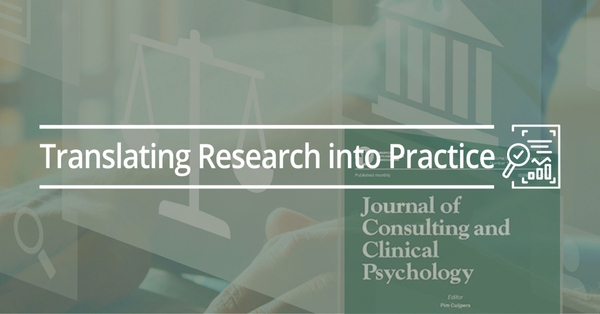Featured Article
Article Title
Clinical Science and Practice in the Age of Large Language Models and Generative Artificial Intelligence
Authors
Stephen M. Schueller; Department of Psychological Science, University of California, Irvine; Department of Informatics, University of California, Irvine
Robert R. Morris; Koko, San Francisco, California, United States; Center for m2Health, Palo Alto, California, United States
Abstract
Recent advances in large language models (LLMs) and generative artificial intelligence (AI) have led to the development of a host of products that are already revolutionizing the way people and technologies interact. One of the most well-known of these products is ChatGPT, which is an LLM that can generate human-like text and hold conversations on a wide range of topics, but others exist like Bard, based on Google’s Language Model for Dialogue Applications LLM, and Meta’s open source LLM. LLMs have numerous applications, including providing emotional support. This is similar in application to, although more sophisticated than, ELIZA the virtual therapist, a chatbot created in the 1960s. LLMs and generative AI improve on earlier forms of deep learning, wherein a model is laboriously trained with thousands of labeled data points. Generative AI could soon be able to provide self-guided interventions, perhaps even without human supervision. It is unlikely, however, to fully take on the role of a virtual therapist, and it certainly will not replace therapists entirely. Instead, we should focus on what generative AI and LLMs can do, rather than how they mimic or fail to mimic human activities, such as therapy. We review some of their applications and highlight ethical issues to consider to ensure responsible use of these technologies.
Summary of Research
“Although much of the hype of generative AI has resulted from determining whether it can replace therapists, the most near-term solution is how it might supplement therapists or lay individuals providing mental health support, especially in online spaces. Elsewhere, digital mental health interventions (DMHIs) have been conceptualized as technology-enabled services to emphasize the unique and complementary contributions of technology and human service components. Similarly, the use of LLMs and AI should consider their support of humans. Indeed, one application of generative AI is supplementing human intelligence and creativity to create more impactful clinical interventions” (p. 559).
“Research has consistently demonstrated that therapists do not seem to improve over time, despite continued opportunities to hone their craft (Bickman, 1999). One potential reason for this lack of improvement is that therapists rarely receive the type of feedback they need to modify and improve their practices. Generative AI offers the potential to monitor psychotherapy processes through analysis of free text from those sessions. Although some research has explored therapeutic processes through analysis of content, this work has mostly relied on human coders to review and evaluate sessions. LLMs and AI can assess fidelity to psychotherapeutic techniques and common factors such as empathy and validation. With LLMs and AI, this can be done passively, routinely, and quickly, without the use of human coders, and provide therapists with clear and actionable metrics to adjust their techniques” (p. 559).
“Another opportunity for generative AI is to support lay individuals in providing effective and evidence-based practices. Although therapists are trained in various evidence-based practices, several individuals providing mental health and emotional support are not. Peers, volunteers, and hotline operators are a few examples of roles involved in these types of supports. Early efforts have already demonstrated such potential uses of AI including automatically re-writing human generated responses to create more empathy responses. Applications could be expanded to target several specific factors such as more effective interfaces. Translating psychotherapeutic interventions into these formats can be challenging and developing visual interfaces is not the strength of therapists and clinical researchers. However, clinical psychology has over a hundred of years of experience of using the “talking cure” and using that expertise to help train and deploy LLMs could be a potential point of synergy in developing novel DMHIs. The majority of current chatbot-based DMHIs use rule-based systems, but generative AI could supplement and extend these tools. One near-term use case would be adjusting brief and single-session interventions into more dynamic and conversational interactions that combine structured content with generative AI-based chatbot interfaces” (p. 559).
Translating Research into Practice
“The application of generative AI to clinical research and practice will require tackling ethical questions that result from the use of this technology. Two overarching aspects of ethical considerations need to guide these applications. First and foremost, the ethical guidelines of clinical practice need to be upheld ensuring that people are not harmed. However, the costs of not using technological advances also have to be considered. Sufficient mental health resources do not exist to provide support to all people in need. This is especially true for different subpopulations including racial and ethnic minorities, individuals who live in rural populations, and children and adolescents. Clinical applications of LLMs and generative AI should adopt evidence standards frameworks using risk-based classification. Low-risk applications might involve the integration into rules-based programs of traditional DMHIs or that include licensed therapists in-the-loop to guide therapeutic outreaches. However, it is also worth knowing that several “unknown unknowns” might exist when it comes to safety. LLM applications, even those that are tested rigorously in clinical trials, may fail catastrophically when deployed in a naturalistic setting. Real-world usage may result in use cases or risks that are impossible to foresee in advance. This challenge has plagued machine learning systems for years, but has especially severe consequences in clinical therapy settings. Some research already demonstrates limitations of current generative AI in responding to public health questions, undoubtedly other risks exist. Governments have begun to regulate AI, such as the European Union’s AI act that establishes different obligations based on varying levels of risk. Of course, risk may be just another example of “unknown unknowns” (p. 560).
Other Interesting Tidbits for Researchers and Clinicians
“Despite years of research, change on psychotherapeutic interventions changes processes largely remain a black box. The majority of research on these processes use relatively small samples from controlled research settings. AI has advanced opportunities to better understand these processes from larger samples in real- world settings. One study used machine learning to translate therapist utterances from real-world clinical practice into treatment factors to determine which factors most predicted symptom change (Ewbank et al., 2020). This study demonstrated that change factors such as cognitive and behavioral techniques were the strongest predictor of symptom improvement and nontherapy-related content such as hellos, goodbyes, and bridges were negatively related with improvement. LLMs trained on clinical content could identify more specific change factors and even factors associated with different types of treatments that are proposed to be specific mechanisms of action. Such applications could allow us to truly open the black box of psychotherapy and potentially drive better understanding of what works for whom” (p. 560).























.jpg?width=1006&height=503&name=Program_Digital-Mental-Health_Main_Image%20(1).jpg)


